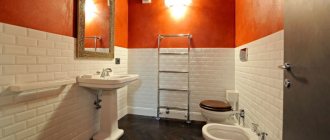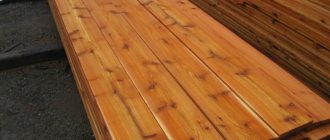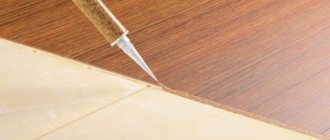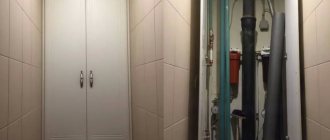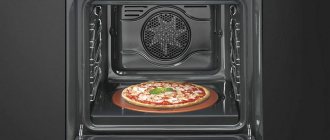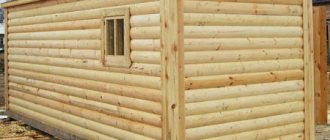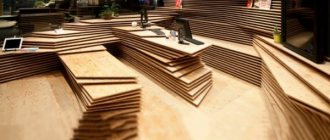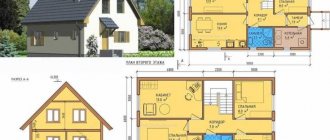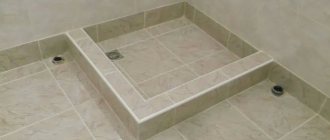Natural wood flooring is warm and comfortable. Using wooden materials in interior decoration, the atmosphere of a room, apartment or house becomes more comfortable and homely. Wooden flooring is pleasant to the touch, which is why many people like to walk on it barefoot.
Wood is an environmentally friendly material, which means it is safe for human health, which is ideal for people prone to allergic reactions.
Thanks to its excellent characteristics, wooden floors are loved by many and are very popular among construction and finishing materials. I would especially like to highlight the larch floor, but we will try to understand in more detail what it looks like and why it is valued.
Characteristic properties
Siberian larch has long conquered everyone with its unique properties and has a large army of fans, but few know
Legs for structure
Drawing of a coffee table made of boards.
The legs are made from the same material as the tabletop. For one leg, both parts will be connected “half a tree”. Boards for making legs are marked as follows:
- You need to draw a rectangle on a sheet of fiberboard or plywood. Its dimensions are determined by the formula “A”X600 mm. Here A=750 - b (that is, the thickness of the tabletop, calculated in millimeters);
- The board is placed diagonally across the rectangle so that different edges of the board are in opposite corners. Now you can mark the line along which you will need to cut the boards, the “junction” on one and the other boards.
Option for attaching table legs.
After marking the parts of the legs, they are cut to length, and a selection of half a tree is made on each. Next, everything is adjusted and assembled using PVA glue with the addition of small sawdust and several screws. After the legs of the table are assembled, they must be attached to the bars of the tabletop using furniture screws; the stiffening rib must be strengthened between the legs - this is done using long self-tapping screws. You can cover both ends of the tabletop with bars; to secure them, use nails whose heads have been previously “bitten off.” They should be sunk into the wood with one blow of the hammer.
almost ready. It is highly advisable to color the product. To do this, you can use stain or clear water-based acrylic varnish. This ensures protection from precipitation and external influences.
Moisture resistance
Its main difference from other tree species is its stability in a humid environment. In the distant past, larch was used to construct ship decks, support and pile structures for bridges and buildings.
The whole trick lies in the fact that when exposed to water, it becomes more durable, not inferior to stone. Therefore, when purchasing larch wood for flooring, you can be sure that over time it will only become harder and more durable.
Caring for larch boards
Larch floors require proper care and periodic renewal of the surface. Layed wood needs to be refreshed on average every three years. The frequency of repairs and the consumption of varnish for larch floors are determined by the traffic flow of the room.
Varnishing a larch floor using a roller
You can update not the entire surface of the room at a time, but only certain areas. The application of the protective agent is preceded by cleaning the worn-out floor area.
It is advisable to carry out cleaning without household chemicals. It is better to wash the floor not with a wet, but with a slightly dampened cloth. Then it is advisable to wipe the surface dry. If wet cleaning is not required, simply clean the surface with a vacuum cleaner. Rugs help preserve the floor and reduce abrasion.
Thermal insulation
Excellent thermal insulation makes the material indispensable for use in residential buildings due to its ability to retain heat.
In addition, larch wood is resistant to various loads, and you can safely walk on it in heels or install furniture on legs.
Repair of tongue and groove floors
Tongue and groove floors are quite reliable, but during use, damage to one or more boards may occur. Then they are taken out of the common monolith of the floor and replaced with new ones. To do this, the ridges of the boards are cut with a circular saw with a rounded blade end. You can also use a jigsaw or a hacksaw with a narrow blade.
Replacing boards is carried out according to the following scheme:
- Several cuts are made along the board to be replaced with a saw, jigsaw or hacksaw. The depth of the cuts is slightly less than the thickness of the board, that is, without through slots.
- Using a chisel, punch the ridges of the boards along the slots.
- Remove the damaged board and the remains of the ridge from the groove.
- A new board is inserted in place of the removed board.
Thus, by replacing damaged boards as necessary, you can extend the life of your tongue and groove floor for many decades.
Purpose
Basically, larch boards are used for flooring inside an apartment or house, an open terrace or veranda. Laying floorboards is quite simple; for this purpose, they are equipped with tenons, grooves and cuts, thanks to which the boards are tightly connected to each other.
For installation on the terrace, deck timber is usually used, which is installed with minimal gaps and rounded corner chamfers to prevent dirt and water from accumulating.
Most often, deck beams are used in public places, in open areas, in saunas and baths, i.e. in conditions of high humidity or direct contact with water.
For insulating floors on balconies and loggias, larch is an ideal solution, since it is not susceptible to various types of influences: open sun, bad weather, insects and fungi. In the production of parquet, solid floor boards of small dimensions are used.
Varieties and prices
There are different categories of flooring that vary in cost. Belonging to a particular grade depends on the quality of the wood, the presence of knots, and the tendency to crack. The price also depends on the thickness of the floor board:
| Wood type | Price range (RUB per m2) |
| Extra | 1350 — 2500 |
| Prima | 1250 — 2300 |
| Category A | 1050 — 2000 |
| Category B | 900 — 1700 |
| Category C | 700 – 900 |
Features of choice
To make the right choice of larch material, you need to know what to consider first.
Protecting wood from external influences is the key to the reliability of a country houseWood is a natural raw material and a wonderful material
All about wooden lining - quality assessment, advantages of use and characteristics of the finishing material
Firstly, it is worth checking that the actual dimensions correspond to those indicated. Take a tape measure and measure the thickness, width and length. This is necessary so that during the installation process there are no difficulties that can arise even due to a small error of 2-3 mm.
Secondly, pay attention to the strength of the tongue-and-groove connection, because the stability, durability and reliability of the structure as a whole depends on this. To do this, connect two boards together.
Thirdly, the surface of the board must be smooth, without chips or other surface defects.
What to look for when choosing material and laying the floor
When choosing flooring boards, consider the following points:
- Buy high-quality boards that do not have cracks, scratches, or chips.
- Boards deformed as a result of improper drying are unsuitable for laying floors.
- Ask the seller for a quality certificate, check what chemicals were used to impregnate the timber, and whether they are safe for humans.
- Check all the dimensions of the boards you purchase; even a small difference in thickness will create a lot of problems during installation.
- Check the alignment of the grooves and tenons by placing the boards end to end.
- If the packaging contains condensation, refuse to purchase; most likely, the humidity of the product is high.
Before laying floorboards, it is necessary to carefully level the surface and take care of the ventilation of the underground space in advance. The purchased product must be unpacked and left for several days in the room where it will be stored.
This is necessary so that the humidity of the building material and the air in the room are equal. Floorboards are laid on joists, plywood, or old wooden floorboards.
The boards are secured in the following way:
- The first board is laid with a tenon to the wall at a distance of 1 cm. This gap is necessary to prevent deformation of the material during its possible expansion.
- The board is secured with self-tapping screws from the wall side; later, the fasteners will be covered by the plinth.
- A second board is placed nearby so that its tenon fits into the groove of the first board. To reduce the size of the gap, use a mallet.
- All that remains is to fill the entire row with boards.
The last board may need to be cut to size in width. All that remains is to sand the surface, cover it with a protective layer of varnish or wax, and install the baseboards. If the floor is laid on the ground floor, take care of reliable thermal insulation so that the material does not experience sudden temperature changes.
Installation technology
How to lay a tongue and groove board on the floor depends on the type of base. This could be a concrete screed, plywood or chipboard flooring, or an old board covering. The main condition: it must be smooth and durable and prevent the boards from getting wet from below.
But most often, installation is carried out on logs, since they allow you to raise the flooring above the base, waterproof and insulate it, and provide good ventilation to the boards. When laying thermal insulation materials under the floor, be sure to leave a gap between them and the back surface of the boards for free air movement.
The logs are installed with a certain pitch, which is selected taking into account their cross-section and the thickness of the boards (the recommended parameters are given above). When joining the lags along their length, a small gap is left between them for thermal expansion.
Aspect #4 - Humidity
The ideal moisture content of tongue and groove boards is 12-16%.
If the boards are poorly dried, then deformation of the finished floor is inevitable. Cracks and warping of boards often occur. There will almost certainly be gaps between the boards, so the floor will have to be re-laid.
The moisture content of the boards can be determined using a moisture meter. If this device is not available, you can get by with simpler evaluation methods:
When tapped with your knuckles, dry (suitable for flooring) wood produces a ringing, clearly audible sound. A wet board, on the contrary, sounds dull, barely audible. If you touch a wet board, you can feel the dampness. There is no feeling of moisture on a dry board. The color of a wet board is darker than that of a dry board.
Also, after high-quality industrial drying, the surface of the board acquires a noticeable shine. A damp board remains matte. There should be no condensation inside the packaging film. Droplets of moisture on the film always indicate excessive moisture on the boards.
